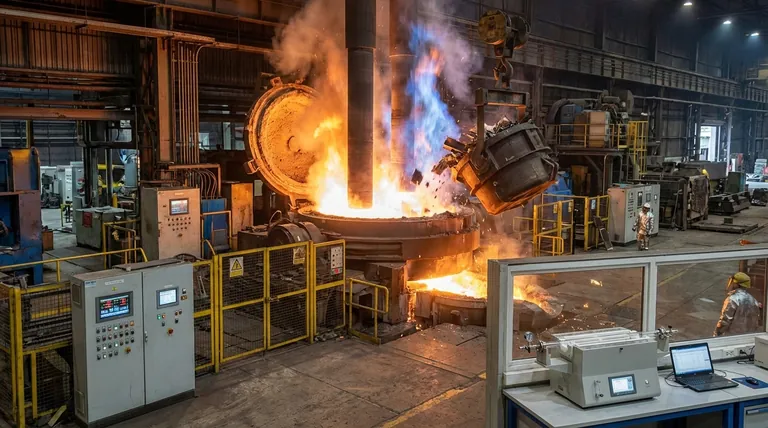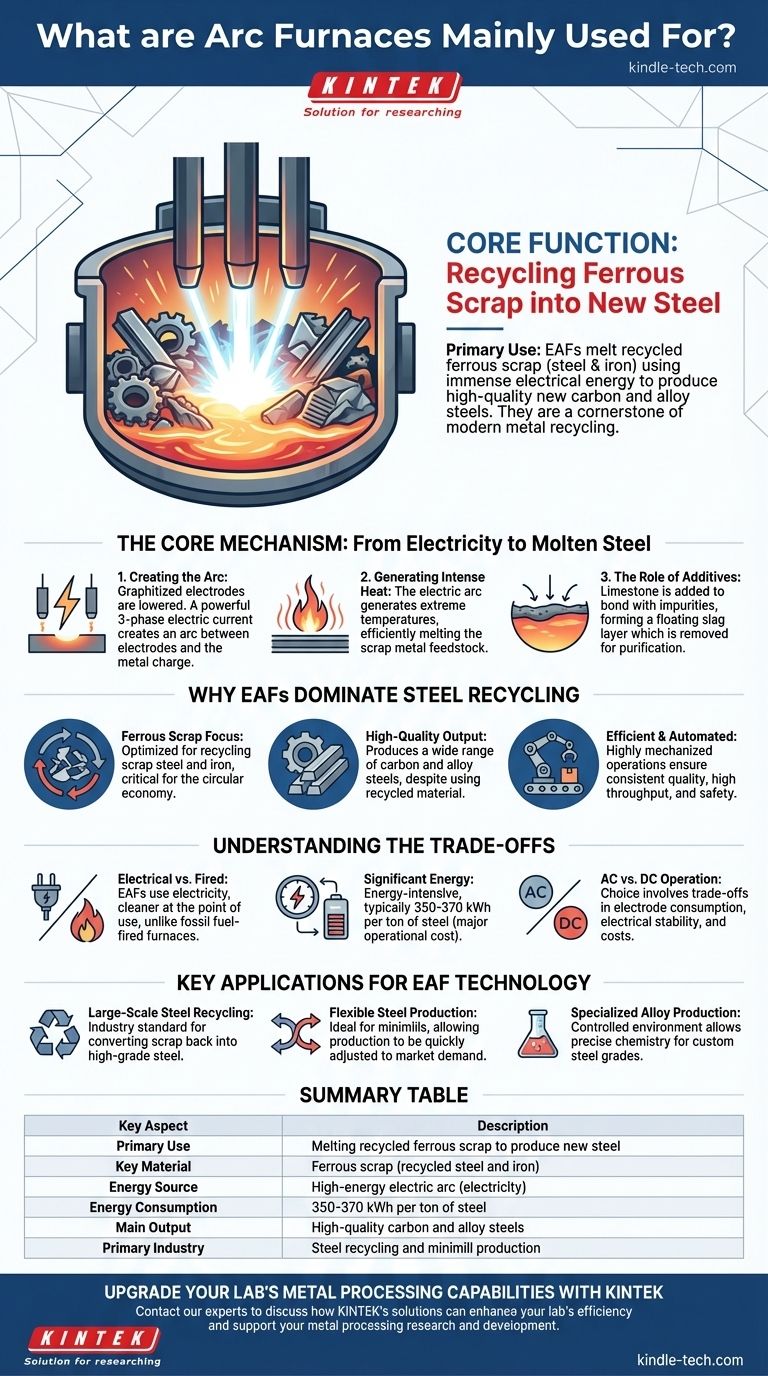At their core, electric arc furnaces (EAFs) are primarily used to produce new carbon and alloy steels by melting recycled ferrous scrap. They are a cornerstone of modern metal recycling, using immense electrical energy to transform scrap metal into high-quality liquid steel ready for manufacturing.
The essential role of an electric arc furnace is to act as a powerful recycling engine for the steel industry. It uses a high-energy electric arc to efficiently melt down scrap steel, providing a flexible and more sustainable alternative to producing steel from raw iron ore.

The Core Mechanism: From Electricity to Molten Steel
An electric arc furnace does not burn fuel in the traditional sense. Instead, it leverages the raw power of electricity to generate the extreme temperatures needed to melt metal.
Creating the Arc
The process begins with lowering massive graphitized electrodes into a furnace filled with scrap metal. A powerful three-phase electric current is applied to these electrodes.
An electric arc then forms between the electrodes and the metal charge itself, creating a circuit.
Generating Intense Heat
This arc is a concentrated discharge of electrical energy, which generates immense heat. It is this intense, direct heat that melts the scrap metal efficiently and quickly.
The Role of Additives
During the melting process, materials like limestone are added to the furnace. These additives bond with impurities in the molten metal, forming a layer of slag that floats on top.
This slag is then removed, which is a critical step in purifying the steel before it is tapped from the furnace.
Why Arc Furnaces Dominate Steel Recycling
While other furnace types exist, the EAF is uniquely suited for the specific task of recycling scrap. Its design and operation are optimized for this feedstock.
The Focus on Ferrous Scrap
The primary material, or "charge," for an EAF is ferrous scrap—recycled steel and iron. This makes the EAF a critical component of the circular economy for steel.
High-Quality Steel Production
Despite using recycled material, EAFs are capable of producing a wide range of high-quality steels. They can produce both common carbon steel and more specialized alloy steels by adding specific elements to the molten bath.
An Efficient, Automated Process
Modern arc furnace operations are highly mechanized and automated. This ensures consistent quality, high throughput, and safety in an inherently dangerous industrial environment.
Understanding the Trade-offs
The choice of an EAF is based on specific industrial needs and comes with distinct operational considerations compared to other furnace technologies.
Electrical vs. Fired Furnaces
The industrial furnace landscape includes two general types: electrical and fired. Fired furnaces rely on the combustion of fuel (like gas or oil), while EAFs rely solely on electricity. This makes EAFs cleaner at the point of use, with emissions tied to the source of electricity generation.
Significant Energy Requirements
The process is energy-intensive. A typical EAF requires between 350 and 370 kWh of energy to produce a single ton of steel, a major operational cost and consideration. The exact amount depends on the quality and composition of the scrap being used.
AC vs. DC Operation
Two main types of EAFs exist: those that run on alternating current (AC) and those that use direct current (DC). While both achieve the same goal, the choice between them involves trade-offs in electrode consumption, electrical stability, and operational costs.
Key Applications for EAF Technology
The application of an electric arc furnace is directly tied to the desired outcome and available raw materials.
- If your primary focus is large-scale steel recycling: The EAF is the industry-standard technology for efficiently converting scrap metal back into high-grade steel.
- If your primary focus is flexible steel production: EAFs can be started and stopped more readily than traditional blast furnaces, making them ideal for "minimills" that adjust production to market demand.
- If your primary focus is producing specialized alloy steels from scrap: The controlled EAF environment allows for precise chemistry adjustments, making it perfect for creating custom steel grades.
Ultimately, the electric arc furnace stands as a powerful and indispensable tool for sustainable and versatile steel manufacturing worldwide.
Summary Table:
| Key Aspect | Description |
|---|---|
| Primary Use | Melting recycled ferrous scrap to produce new steel |
| Key Material | Ferrous scrap (recycled steel and iron) |
| Energy Source | High-energy electric arc (electricity) |
| Energy Consumption | 350-370 kWh per ton of steel |
| Main Output | High-quality carbon and alloy steels |
| Primary Industry | Steel recycling and minimill production |
Upgrade Your Lab's Metal Processing Capabilities with KINTEK
Whether you're involved in materials research, metallurgical testing, or small-scale alloy development, KINTEK provides the laboratory equipment you need to support your steel and metal analysis workflows. Our specialized furnaces and consumables help researchers and quality control labs achieve precise temperature control and reliable results.
Contact our experts today to discuss how KINTEK's solutions can enhance your lab's efficiency and support your metal processing research and development.
Visual Guide

Related Products
- 1400℃ Laboratory Quartz Tube Furnace with Alumina Tube Tubular Furnace
- Vertical Laboratory Quartz Tube Furnace Tubular Furnace
- 1700℃ Laboratory Quartz Tube Furnace with Alumina Tube Tubular Furnace
- Vacuum Induction Melting Spinning System Arc Melting Furnace
- Laboratory Muffle Oven Furnace Bottom Lifting Muffle Furnace
People Also Ask
- What materials are used for the tubes in tube furnaces? A Guide to Selecting the Right Tube for Your Process
- What are the benefits of a tube furnace? Achieve Superior Temperature & Atmosphere Control
- What are the advantages of a tube furnace? Achieve Superior Temperature Uniformity and Control
- What is a tube furnace used for? Achieve Precise, Controlled Thermal Processing
- What is a tubular furnace used for? Precision Heating for Material Synthesis & Analysis



















